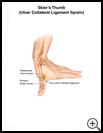
Skier's Thumb (Ulnar Collateral Ligament Sprain)
________________________________________________________________________
KEY POINTS
- Skier’s thumb is an injury to a ligament at the base of your thumb, where the thumb attaches to your hand.
- You will need to change or stop doing the activities that cause pain until the ligament has healed.
- Treatment may include stretching and strengthening exercises, a cast, taping, or splinting. If the sprain is severe, you may need surgery.
________________________________________________________________________
What is skier’s thumb?
Skier’s thumb is an injury to a ligament in your thumb. It happens at the base of the thumb, where the thumb attaches to your hand. Ligaments are strong bands of tissue that connect one bone to another to form the joints. When a ligament is injured, it can be stretched, partially torn, or completely torn.
A ligament injury is also called a sprain.
What is the cause?
Skier's thumb usually happens during a sudden activity that twists or tears a ligament, like if you:
- Fall onto your outstretched thumb and bend it back toward your arm
- Catch your thumb on a ski pole strap
- Hook your thumb onto something that pulls it back toward your arm, like a football player's jersey or facemask
What are the symptoms?
Symptoms may include:
- Pain, swelling, and tenderness at the inner part of your thumb and hand
- Trouble applying force with your thumb
- Trouble holding something with your thumb and index finger
- Pain when you move your thumb
- A looseness of the joint at the base of your thumb where it attaches to your hand
How is it diagnosed?
Your healthcare provider will examine you and ask about your symptoms, activities, and medical history. You may have X-rays or other scans.
How is it treated?
You will need to change or stop doing the activities that cause pain until the ligament has healed.
Your healthcare provider may recommend stretching and strengthening exercises to help you heal.
Some sprains may be treated with a cast, taping, or splinting so that your thumb does not move for up to 6 weeks.
If the sprain is severe, you may need surgery to repair or rebuild the torn ligaments.
The pain often gets better within a few weeks with self-care, but some injuries may take several months or longer to heal. It’s important to follow all of your healthcare provider’s instructions.
How can I take care of myself?
To reduce swelling and pain for the first few days after the injury:
- Put an ice pack, gel pack, or package of frozen vegetables wrapped in a cloth on the injured area every 3 to 4 hours for up to 20 minutes at a time.
- Keep your hand up on pillows so that it is above the level of your heart when you sit or lie down.
- Take nonprescription pain medicine, such as acetaminophen, ibuprofen, or naproxen. Read the label and take as directed. Unless recommended by your healthcare provider, you should not take these medicines for more than 10 days.
- Nonsteroidal anti-inflammatory medicines (NSAIDs), such as ibuprofen, naproxen, and aspirin, may cause stomach bleeding and other problems. These risks increase with age.
- Acetaminophen may cause liver damage or other problems. Unless recommended by your provider, don't take more than 3000 milligrams (mg) in 24 hours. To make sure you don’t take too much, check other medicines you take to see if they also contain acetaminophen. Ask your provider if you need to avoid drinking alcohol while taking this medicine.
Follow your healthcare provider's instructions, including any exercises recommended by your provider. Ask your provider:
- How and when you will get your test results
- How long it will take to recover
- If there are activities you should avoid and when you can return to your normal activities
- How to take care of yourself at home
- What symptoms or problems you should watch for and what to do if you have them
Make sure you know when you should come back for a checkup. Keep all appointments for provider visits or tests.
How can I help prevent an ulnar collateral ligament sprain?
Follow safety rules and use any protective equipment recommended for your work or sport. Try using ski poles without straps.

